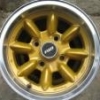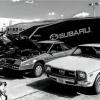Leaderboard
Popular Content
Showing content with the highest reputation on 08/06/18 in Posts
-
You have to get the trans dipstick out because that's how you fill the transmission! You should of course do a drain and fill on the fluid ASAP because it's liable to really be bad. It's really hard to get a straight pull on the depstick. How about trying vice grips between the hoses? You can put a hair dryer on it for a while to get it hot. Good luck.2 points
-
Don't pour anything except coolant, water or "water wetter" type additives. "Stop Leak" type products should be called Stop Flow instead...2 points
-
Yes, I built my roof rack with aluminum and used stainless hardware. Sometime later, when to check or modify, and yikes, bolts were very stuck in holes. Investigated a bit, and yes, it is a thing, bad combination. I re did the thing using anti seize, been Ok since. I didn't go to steel in that application, to avoid.rust stains on the paint, but on an engine, that's not an issue. The strength and expansion rates are. The anti seize solves the stuck bolts problem on the engine.2 points
-
I can't get over the commercial for the XT turbo back in the day. There's a quick shot of the cluster and if you look close the temp is one bar below the red.1 point
-
1 point
-
You may have just captured your issue, that looks like an aftermarket axle, unless the grease covered inner joint is deceiving me. Aftermarket axles are notoriously problematic, I would replace them even if they are not making the noise. They're not long time reliable components, they're risky trash for penny-wise-dollar-dumb time wasters and used car flippers. You could alternately pull the boots back and clean and regrease them. More than likely they didnt' have enough grease or it's watery and degraded and knocking...or it's one of those and the joint is a trashed POS, that's no surprise either. You would want to concentrate on the inner joints - they're the ones that have the exact symptoms you're describing when they lack (good) grease. But for my time and money I'd just throw those away and get Subaru OEM axles. $15-$35 all day long on car-part.com or local yards. buy one, clean it, reboot it. i've rebooted open-boot, dirty as #(!)%* knocking, clicking Subaru axles and never had an issue, they've all quieted right up with no failures. i've had multiple brand new aftermarket axles blow apart within 50 miles (one was less than 100 yards that was awesome) and have multiple other issues besides that. which is funny because I spend way more time and miles with OEM so I should see more OEM failures...but nope, it's the aftermarkets blowing away the competition...quite literally.1 point
-
That's a common indication that the steering column ujoint should be checked. the ujoint gets notchy and catches are very specific points in the steering wheel arc. And you never answered my question to verify the ujoint: It doesn't seem like you took it off to inspect it? But...maybe you don't need to with the new info... That's definitely telling but i wouldn't necessarily condemn it immediately based on what's typed in this thread so far. 1. repair it - new Duty C and clutches. Very roughly $1,000. 2. drive it with the FWD fuse indefinitely, taking it out when the roads are bad. 3. install a switch so you can flip between FWD and "locked" or just nominal AWD. I've done this to numerous subarus. It's advantageous to be able to "lock" it at will and it's an easy work around for torque bind, or other issues, in automatics. it's really easy - involves one wire and very simple wiring of a basic switch.1 point
-
Likewise here & my 87 GL sees long stretches of hwys thru current 100+ temps in desert areas. Running a dual brass core radiator & mindful of those pesky faults of an EA82. Such as the small bypass hoses & heater hoses that are often overlooked. Another is thoroughly purging the air out of the system. A must for any liquid cooled engine. Any of those quick cures like Alumaseal can spell the end of a radiator when tubes get clogged with that junk. For my rig the temp gauge stays just below center of range most of the time.1 point
-
The OBD port is fused IIRC SBF fuse #4 in engine bay. Check it. Are you plugging it in AFTER you turn the key? If not you will get a link error. Here is link to FSM: http://jdmfsm.info/Auto/Japan/Subaru/ Wiring etc is in there to check your lines. O.1 point
-
I ran little wire to little wire and big wire to big wire and its charging like it supposed to now1 point
-
We subscribe to the "run it hard" break-in theory. That doesn't mean WOT pulls from the first start up, but we did this method on our last rebuild and it has proven to not use a drop of oil in the last 50k+ miles: Fill brand new engine with either break-in-specific oil or cheap 30w dino oil. Start, idle and check for leaks, drips, new engine type stuff. (optional, stop engine, change oil & filter, cheap dino 30w or break-in specific) Take car for a drive along a route with as much change in elevation as possible, varying throttle positions and engine speed. There is no need for WOT or redline shifting, but DO NOT baby the engine. If its turbocharged, try to stay out of boost, but get as close as you can to 0 in/hg and psi as possible. If N/A, half to 3/4 throttle is acceptable. When you have the opportunity to engine brake from medium high rpm, take it! Use engine braking as much as you can during your break-in test drive. (optional, stop engine, change oil & filter, cheap dino 30w or oil of your choice) Drive normally varying engine speed and throttle position (avoid WOT and high gear, high throttle situations) for the next 1,000-3,000 miles. Change oil & filter. Now you're good to go!1 point
-
power ports are also fused directly behind the port so, you probably need to get the cig lighter out of the trim and check it's backside. not uncommon for older soobs to have bad wiring in the boot from the body to the hatch. Soldering in splices can help for quite a while and is cheaper than a new harness. other issues you mention could be related to ground connections that need refreshing. take em loose. wire brush every surface of the lugs and the bolt and the body or manifold w'ever it came from, re-assemble and smear with dielectric grease. hope others here have more specific help for you.1 point
-
This is the one I used. Going on two years, no issues. https://www.ebay.com/itm/REMAN-A-C-COMPRESSOR-COMFORT-TEMP-57453R-FITS-1994-SUBARU-LOYALE-1-8L/132232695464?epid=76242066&hash=item1ec9aecea8%3Ag%3AZsgAAOSwPWRZSDQ4&_nkw=57453&_from=R40&rt=nc There are (at least) two different back cases for this model compressor, the one you see with the rear fitting on the side of the back case, and one with the fitting on the back of the back case (the compressor itself is identical.) They sent the wrong case, but made it right with no cost to me, I just had to explain, "the one like in the picture," and attached a picture of what they sent vs what I had, with what was posted. Very nice people to deal with. And it won't work without the second belt. With only one belt, it will slip, and the lockup safety will kick the compressor out. Good luck! Dan1 point
-
My EA81 hasn't been so happy this summer. I have had her about three years and suspected a head gasket among other things, such as a leaky heater core, all minute but serious enough to purge some coolant. I am planning to try some BlueDevil Head Gasket Sealer. Wish me luck.0 points
-
Heat it up with a space heater and a heat gun before you attempt to remove any more bolts. Get it near normal operating temperature, it makes a big difference. When you reassemble, use anti seize compound. I would not use stainless steel in an aluminum block. The electrolysys and corrosion that occurs is worse than steel.0 points





.thumb.jpg.96479a473cd1ed4b8bac667c0ee181f5.jpg)

